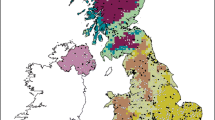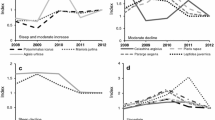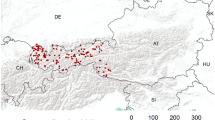Abstract
Changes in butterfly populations are routinely monitored using transect counts, for example from the UK Butterfly Monitoring Scheme. However, abundance trends are typically only calculated at national and country level in the UK. A new method is presented that estimates species’ trends for smaller regions or datasets, where there may be limited transects. National approaches rely on larger numbers of transects and estimate flight periods either at site level, at the cost of excluding data, or assume a fixed flight period across transects to maximise data usage. The new approach uses butterfly records from all available sources to estimate a parameterised curve representing the flight period and create a so-called Dummy site. Counts from the Dummy site are included with true transect counts in a generalised additive model to estimate annual flight periods as fixed across sites, from which counts and abundance indices are estimated. Inclusion of the Dummy site produces a better overall fit, with greater influence for species with limited transects. Regional indices were often comparable with those produced from a national analysis, but with more realistic indices for some species. Trends were usually similar in magnitude and sign, but for certain species the new approach estimated more robust trends, benefiting from the inclusion of more data through estimating a common regional flight period. The approach is demonstrated for butterflies in Surrey (UK) but has wider relevance, for example to newly-established or small-scale monitoring schemes which may exploit alternative data sources to inform species’ flight period estimation.






Similar content being viewed by others
Change history
06 August 2020
In the Original publication of the article, Table 1 was published incorrectly. The correct Table 1 is given in this Correction.
References
Agassiz DJL, Beavan SD, Heckford RJ (2013) Checklist of the Lepidoptera of the British Isles. Royal Entomological Society, London
Asher J, Warren M, Fox R, Harding P, Jeffcoate G, Jeffcoate S (2001) The Millennium Atlas of Butterflies in Britain and Ireland. Oxford University Press, Oxford
Bishop TR, Botham MS, Fox R, Leather SR, Chapman DS, Oliver TH (2013) The utility of distribution data in predicting phenology. Methods Ecol Evol 4(11):1024–1032. https://doi.org/10.1111/2041-210x.12112
Brereton TM, Cruickshanks KL, Risely K, Noble DG, Roy DB (2010) Developing and launching a wider countryside butterfly survey across the United Kingdom. J Insect Conserv 15(1–2):279–290. https://doi.org/10.1007/s10841-010-9345-8
Brereton TM, Botham MS, Middlebrook I, Randle Z, Noble DG, Harris S, Dennis E, Robinson A, Peck K, Roy DB (2019) United Kingdom Butterfly Monitoring Scheme report for 2018. Tech. rep., Centre for Ecology & Hydrology, Butterfly Conservation, British Trust for Ornithology and Joint Nature Conservation Committee
Cayton HL, Haddad NM, Gross K, Diamond SE, Ries L (2015) Do growing degree days predict phenology across butterfly species? Ecology 96(6):1473–1479. https://doi.org/10.1890/15-0131.1
Collins GA (1995) Butterflies of Surrey. Surrey Wildlife Trust
Copp C (2003) Watsonia Vice county boundary project: Completion of the digitised standard of the UK Watsonian Vice county boundary maps
Dandy JE (1969) Watsonian Vice-counties of Great Britain. 146, Ray Society, London
Dennis EB, Freeman SN, Brereton T, Roy DB (2013) Indexing butterfly abundance whilst accounting for missing counts and variability in seasonal pattern. Methods Ecol Evol 4(7):637–645. https://doi.org/10.1111/2041-210x.12053
Dennis EB, Morgan BJ, Freeman SN, Brereton TM, Roy DB (2016) A generalized abundance index for seasonal invertebrates. Biometrics 72(4):1305–1314. https://doi.org/10.1111/biom.12506
Department for Environment, Food and Rural Affairs (2019) UK biodiversity indicators 2019
Fox R, Warren MS, Breteton TM (2010) The butterfly Red List for Great Britain: Species status 12
Fox R, Harrower CA, Bell JR, Shortall CR, Middlebrook I, Wilson RJ (2019) Insect population trends and the IUCN red list process. J Insect Conserv 23(2):269–278
Isaac NJ, Jarzyna MA, Keil P, Dambly LI, Boersch-Supan PH, Browning E, Freeman SN, Golding N, Guillera-Arroita G, Henrys PA et al (2020) Data integration for large-scale models of species distributions. Trends Ecol Evol 35:56–67. https://doi.org/10.1016/j.tree.2019.08.006
Knaus J, Porzelius C, Binder H, Schwarzer G (2009) Easier parallel computing in R with snowfall and sfcluster. R J 1(1):54–59. https://doi.org/10.32614/RJ-2009-004
Macgregor CJ, Thomas CD, Roy DB, Beaumont MA, Bell JR, Brereton T, Bridle JR, Dytham C, Fox R, Gotthard K et al (2019) Climate-induced phenology shifts linked to range expansions in species with multiple reproductive cycles per year. Nat Commun 10(1):1–10. https://doi.org/10.1038/s41467-019-12479-w
Matechou E, Dennis EB, Freeman SN, Brereton T (2014) Monitoring abundance and phenology in (multivoltine) butterfly species: a novel mixture model. J Appl Ecol 51(3):766–775. https://doi.org/10.1111/1365-2664.12208
McCullagh P, Nelder JA (1989) Generalized linear models, 2nd edn. Chapman and Hall/CRC, Boca Raton
Pannekoek J, van Strien A (2005) TRIM 3 Manual. TRends and Indices for Monitoring data
Pollard E, Yates TJ (1993) Monitoring butterflies for ecology and conservation: the British butterfly monitoring scheme. Chapman & Hall, London
Robert CP, Casella G (2004) Monte Carlo statistical methods, 2nd edn. Springer, New York
Rothery P, Roy DB (2001) Application of generalized additive models to butterfly transect count data. J Appl Stat 28(7):897–909. https://doi.org/10.1080/02664760120074979
Roy DB, Asher J (2003) Spatial trends in the sighting dates of British butterflies. Int J Biometeorol 47(4):188–192. https://doi.org/10.1007/s00484-003-0170-6
Roy DB, Rothery P, Breteton T (2007) Reduced-effort schemes for monitoring butterfly populations. J Appl Ecol 44(5):993–1000. https://doi.org/10.1111/j.1365-2664.2007.01340.x
Schmucki R, Pe’er G, Roy DB, Stefanescu C, Van Swaay CA, Oliver TH, Kuussaari M, Van Strien AJ, Ries L, Settele J et al (2015) A regionally informed abundance index for supporting integrative analyses across butterfly monitoring schemes. J Appl Ecol 53:501–510. https://doi.org/10.1111/1365-2664.12561
Secretariat of the Convention on Biological Diversity (2007) Year in review 2006
The R Core Team (2019) R: A Language and Environment for Statistical Computing. R Foundation for Statistical Computing, Vienna, Austria, http://www.R-project.org/
Van Swaay C, Dennis E, Schmucki R, Sevilleja C, Balalaikins M, Botham M, Bourn N, Brereton T, Cancela J, Carlisle B, et al. (2019) The EU Butterfly Indicator for Grassland species: 1990–2017: Technical Report. Butterfly Conservation Europe & ABLE/eBMS
Willmott K, Bridge M, Clarke HE, Kelly F (2013) Butterflies of Surrey revisited. Surrey Wildlife Trust
Wood SN (2017) Generalized additive models: an introduction with R, 2nd edn. Chapman and Hall/CRC, Boca Raton
Acknowledgements
Many thanks to Ian Middlebrook for supplying the site indices from the national analysis, to David Roy for comments on an earlier draft of this paper and to the two anonymous reviewers who provided constructive comments of an earlier draft of the paper. The UK Butterfly Monitoring Scheme is organized and funded by Butterfly Conservation, the UK Centre for Ecology & Hydrology, British Trust for Ornithology, and the Joint Nature Conservation Committee. The UKBMS is indebted to all volunteers who contribute data to the scheme. With thanks to all recorders who contribute to the Butterflies for the New Millennium, which is run by Butterfly Conservation with support from Natural England.
Author information
Authors and Affiliations
Corresponding author
Ethics declarations
Conflict of interest
The authors declare that there are no conflicts of interest.
Additional information
Publisher's Note
Springer Nature remains neutral with regard to jurisdictional claims in published maps and institutional affiliations.
Harry E Clarke is the Surrey County Butterfly Recorder and a Butterfly Conservation volunteer
Electronic supplementary material
Below is the link to the electronic supplementary material.
Rights and permissions
About this article
Cite this article
Clarke, H.E., Dennis, E.B. A new method for calculating butterfly abundance trends for small regional areas. J Insect Conserv 24, 779–790 (2020). https://doi.org/10.1007/s10841-020-00251-1
Received:
Accepted:
Published:
Issue Date:
DOI: https://doi.org/10.1007/s10841-020-00251-1




